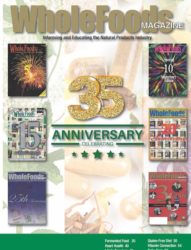There are plenty of foods that grow naturally gluten-free and are easily found in the average grocery store. But for those who don’t want to be restricted and still want to be able to eat pastries and other usually gluten-rich foods, retailers and restaurants are now consistently offering gluten-free alternatives. If celiac disease is something that you suffer from, consult your doctor or a registered dietitian about making diet changes to reduce symptoms.
Shopping Gluten-FreeOne thing people living a gluten-free lifestyle have to think about is cost. Going gluten-free might not cost you more or less than having a regular diet. It can be just a matter of only buying foods that are naturally gluten free. This is a simple approach that limits food options to fruits, vegetables, meat, poultry, dairy, seafood, select grains and beans and excluding things like beer, bread, cereal, couscous, enriched flour, pasta, and various soups and sauces that may use gluten as a thickener (2).
Some gluten-free products may be more expensive, but retailers and manufacturers alike are continually trying to make gluten-free options more affordable and accessible (3). When shopping gluten-free, it’s also important to understand what to look for on the packaging. It’s not always enough for a product to be called “gluten free” as the standards across various brands may differ. This is why one should always seek out products certified by the Gluten Free Certification Organization, which holds manufacturers to strict standards to guarantee a product does not exceed 10 parts per million of gluten, a standard more rigorous than that of the U.S. Food and Drug Administration, which defines gluten-free as not exceeding 20 parts per million (4). The Gluten Free Certified seal can be clearly seen on packaging as “GF” enclosed in a circle.
Baking Gluten-FreeGluten-free food alternatives either have no wheat, rye, or barley and are made with gluten-free grains. There is a variety of grains that are naturally gluten free found in combination in gluten-free flours or on their own. These include aramanth, millet, sorghum, teff, buckwheat, quinoa and brown rice. There are dedicated gluten-free flours designed to replicate conventional all-purpose flour as a direct replacement, while when used on their own, each specific gluten-free grain will offer different flavor profiles and textural properties, requiring more experimentation and experience on the baker’s part.
Gluten is responsible for adding the elastic texture of bread and baked goods. To add elasticity and chewiness to gluten-free applications, manufacturers often add xanthan gum. Xanthan gum is a food additive, made from the fermentation of sucrose, glucose and lactose. The substance is then dried and grinded into a powder. When water is added it becomes gel-like. It acts as a binding agent and basically does everything gluten does. In muffins, for example, xanthum gum is used to prevent them from crumbling. Home bakers can buy xanthan gum separately or purchase a gluten-free flour that already includes it (5).
Cooking Gluten-FreeGluten-free recipes are easy to come by online and once you know what to avoid, keeping a gluten-free diet may be more easily maintained. Here are some meal ideas: Breakfast. Oatmeal with fresh berries; Spinach, tomato and cheese omelet; Fruit smoothie; Waffles or pancakes made with gluten-free flour; Crepes with fruit or roasted vegetables; Quinoa breakfast bowl; Berry parfait (6).
Lunch. Greek salad; Turkey chili and corn bread; Taco salad; Lettuce wraps; Kale salad, Chickpea burgers; Sandwiches with sourdough, gluten-free bread or bread substitutes like corn tortillas or cauliflower bread; Baked no-crust pizza bites; Rice paper rolls (7). Dinner. Baked chicken with steamed vegetables, and brown rice; Pesto chicken and veggies stir fry; London broil with string beans, and mashed potatoes; Ramen noodles made from rice flour; Shrimp tacos with corn tortillas; Grilled salmon and rice; Sushi (7). Snacks. Veggies with hummus; Trail mix; Frozen or dried fruit; Deviled eggs; Potato wedges; Plantain chips; Granola; Ants on a log; Popcorn (8).
Reading LabelsAlways read the nutrition labels and ingredients list. A gluten-free diet is not always as easy as just cutting out bread. All sorts of unexpected foods can have gluten in them. Certain meats like corned beef and salami or name brand chips, chocolate products and yogurt sometimes use gluten as a stabilizer, and grains like oats can be manufactured in places where it could come into contact with gluten. Most yeast is fine, but not brewer’s yeast (2). Just to be safe read labels carefully and/or contact food manufactures if you have any questions. Reading the nutrition facts is important because gluten-free does not equal healthy. You may in fact be eating foods that are just as high in fat and calories as conventional products, maybe even more. Remember, a gluten-free cookie is still a cookie.
References
- https://www.beyondceliac.org/
gluten-free-diet/overview/ - http://www.ibsdiets.org/ibs/
gluten-free-food-list/ - http://www.cbsnews.com/news/a-
gluten-free-diet-how-much- will-it-cost/ - https://www.beyondceliac.org/
gluten-free-diet/reading-food- labels/ - http://blog.kingarthurflour.
com/2015/08/05/xanthan-gum/ - http://www.eatingwell.com/
recipes/18362/gluten-free/ breakfast-brunch/ - http://www.nobiggie.net/25-
gluten-and-dairy-free-lunch- ideas/ - http://www.
thechaosandtheclutter.com/ archives/over-100-gluten-free- snack-ideas










